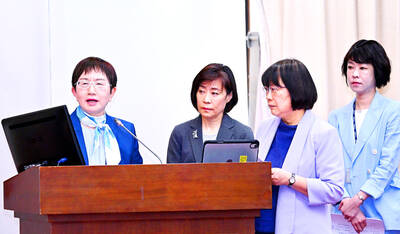HTC Corp’s (宏達電) smartphone shipments are this year expected to underperform Asustek Computer Inc’s (華碩) for the second consecutive year, which hardly makes HTC a major smartphone brand in the global market, analysts said.
Market researcher TrendForce Corp (集邦科技) last week forecast that Asustek’s smartphone shipments would grow 34 percent annually to 21.5 million this year, while HTC’s shipments could drop 27 percent year-on-year to 13 million units.
“We project shipments of HTC’s flagship model M10 will only be about 1 million this year… It is highly unlikely that HTC will be able to regain its past glory as a major brand in the market,” TrendForce analyst Avril Wu (吳雅婷) said in a report released on Thursday.
Asustek has become the leading Taiwanese smartphone brand, mainly because of its low-priced, high-performance handsets, Wu said.
The company’s strategy to switch most of its smartphone processors from Intel Corp’s chips to Qualcomm Inc’s, which are more efficient and generate less heat, also drive demand for Asustek smartphones, Wu said.
With tough competition from Asustek and Chinese vendors, such as Huawei Technologies Co (華為) and Oppo Mobile Telecommunications Corp (歐珀移動), HTC’s handset shipments are expected to fall from last year’s 18 million units, she said.
The 13 million units Wu expects HTC will ship include the Taiwanese company’s additional Nexus smartphone production in the second half of this year for Google.
HTC does not disclose its smartphone shipment numbers.
Yuanta Securities Investment Consulting Co (元大投顧) forecast that HTC would ship a total of 17.7 million smartphones this year, representing a 7.8 percent annual decline from an estimated 19.2 million units last year.
HTC’s smartphone business has not improved, contrary to what the company told investors and shareholders recently, said a Yuanta analyst who declined to be named, citing HTC’s disappointing sales in April and May.
HTC global sales division head Chang Chia-lin (張嘉臨) last month told shareholders that sales of M10 smartphones this year is much better than last year’s sales of the M9 handset.
At that time, Chang said the robust sales of the M10, which hit the market at the beginning of April, had also helped boost demand for the firm’s other handset models by about 20 percent.
However, the Yuanta analyst said Chang’s optimism over the smartphone sales was not reflected in the April-to-May sales figures, which plunged 48.58 percent to NT$12.5 billion (US$388 million) from last year’s NT$24.31 billion.
“Excluding the sales contribution from HTC’s VR headset that also hit the market in April, the scale of annual decline of the company’s smartphone revenues would be more than 48.58 percent,” the analyst said.
That suggests that sales of M10 and HTC’s other smartphones were not as good as the company said, he added.
In light of poor revenues in April and May, the analyst said HTC’s guidance of a smartphone business turnaround in the second half of this year would be difficult, because sales of the M10 is likely to dissipate following its launch in April.

ADVERSARIES: The new list includes 11 entities in China and one in Taiwan, which is a local branch of Chinese cloud computing firm Inspur Group The US added dozens of entities to a trade blacklist on Tuesday, the US Department of Commerce said, in part to disrupt Beijing’s artificial intelligence (AI) and advanced computing capabilities. The action affects 80 entities from countries including China, the United Arab Emirates and Iran, with the commerce department citing their “activities contrary to US national security and foreign policy.” Those added to the “entity list” are restricted from obtaining US items and technologies without government authorization. “We will not allow adversaries to exploit American technology to bolster their own militaries and threaten American lives,” US Secretary of Commerce Howard Lutnick said. The entities

‘SWASTICAR’: Tesla CEO Elon Musk’s close association with Donald Trump has prompted opponents to brand him a ‘Nazi’ and resulted in a dramatic drop in sales Demonstrators descended on Tesla Inc dealerships across the US, and in Europe and Canada on Saturday to protest company chief Elon Musk, who has amassed extraordinary power as a top adviser to US President Donald Trump. Waving signs with messages such as “Musk is stealing our money” and “Reclaim our country,” the protests largely took place peacefully following fiery episodes of vandalism on Tesla vehicles, dealerships and other facilities in recent weeks that US officials have denounced as terrorism. Hundreds rallied on Saturday outside the Tesla dealership in Manhattan. Some blasted Musk, the world’s richest man, while others demanded the shuttering of his

Minister of Finance Chuang Tsui-yun (莊翠雲) yesterday told lawmakers that she “would not speculate,” but a “response plan” has been prepared in case Taiwan is targeted by US President Donald Trump’s reciprocal tariffs, which are to be announced on Wednesday next week. The Trump administration, including US Secretary of the Treasury Scott Bessent, has said that much of the proposed reciprocal tariffs would focus on the 15 countries that have the highest trade surpluses with the US. Bessent has referred to those countries as the “dirty 15,” but has not named them. Last year, Taiwan’s US$73.9 billion trade surplus with the US

Prices of gasoline and diesel products at domestic gas stations are to fall NT$0.2 and NT$0.1 per liter respectively this week, even though international crude oil prices rose last week, CPC Corp, Taiwan (台灣中油) and Formosa Petrochemical Corp (台塑石化) said yesterday. International crude oil prices continued rising last week, as the US Energy Information Administration reported a larger-than-expected drop in US commercial crude oil inventories, CPC said in a statement. Based on the company’s floating oil price formula, the cost of crude oil rose 2.38 percent last week from a week earlier, it said. News that US President Donald Trump plans a “secondary